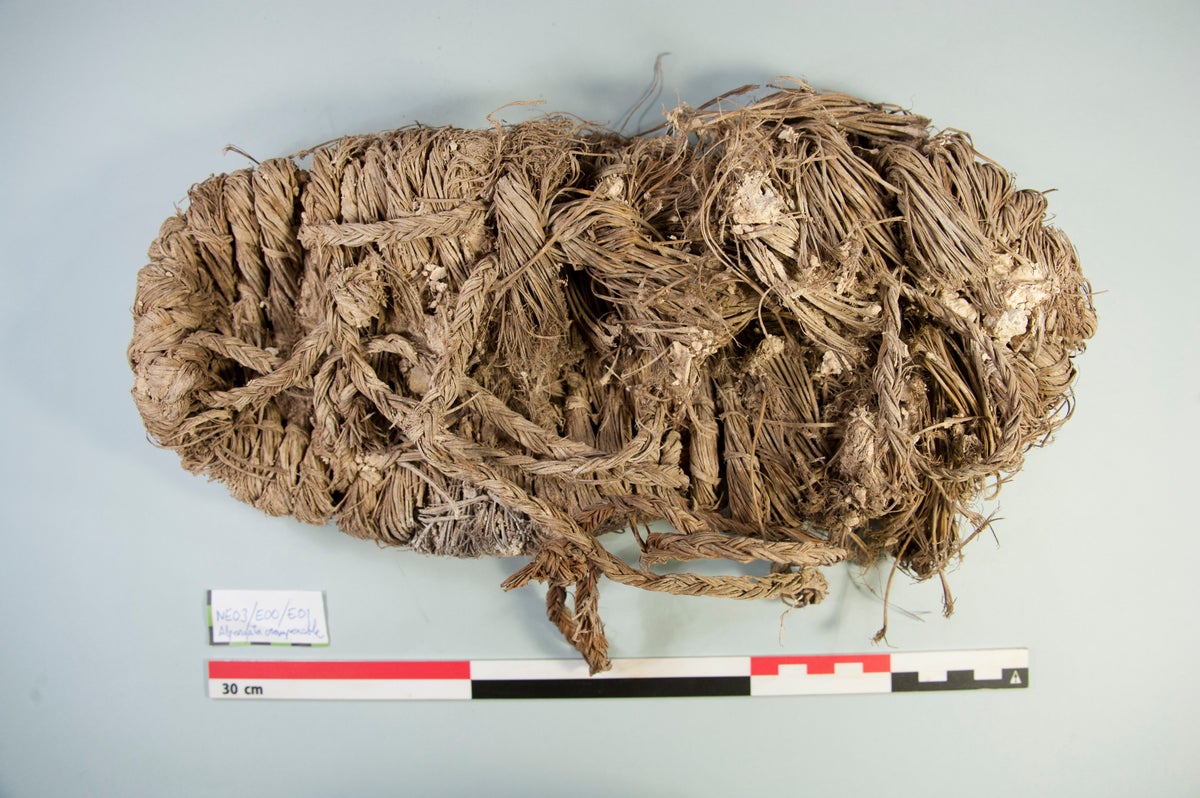In the rugged cliffs of southern Spain, an extraordinary archaeological discovery has shed new light on over six centuries of human history—hidden in the nesting sites of the bearded vulture, also known as the quebrantahuesos or “bonebreaker.” This remarkable bird, famous for its bone-crushing feeding habits, has unwittingly served as a collector of human artifacts, creating natural “time capsules” in its remote cliffside nests that preserve traces of human life dating back more than 600 years.
Scientists, employing the daring technique of cliff rappelling to access these inaccessible nesting caves, have uncovered a fascinating array of objects embedded within layers of eggshells, sticks, and ancient bones. Among the most intriguing finds are 25 shoes made from woven esparto grass, a traditional material used in the region. One shoe, in particular, dates back more than 670 years and belongs to a style known for being worn only briefly before being repaired or replaced. This discovery provides a rare glimpse into the everyday lives and material culture of people living centuries ago.
The researchers’ investigations have also unearthed other remarkable artifacts, including a crossbow bolt, part of a slingshot, and even a fragment of sheep leather adorned with red decorations that archaeologists speculate might be a “very peculiar mask.” These items, preserved by the dry, protected conditions inside the cliffside caves, offer a unique window into the past, revealing not only human activity but also environmental conditions spanning centuries.
The preservation of these artifacts owes much to the extraordinary environment of the nesting caves. With low humidity and shelter from wind and rain, these cliffside locations provide ideal conditions for the long-term survival of delicate materials that would normally degrade rapidly. Sergio Couto, a biologist at the University of Granada and co-author of the recent study published in the journal Ecology, highlights the inaccessibility of these sites: “These are the most inaccessible places you can imagine. It’s impossible to enter if you cannot fly,” he says, emphasizing the difficulty and risk involved in studying these natural repositories.
The bearded vultures themselves have played a critical role in shaping these archaeological records. Unlike many other vulture species that build nests hastily just before laying eggs, bearded vultures invest months crafting two or three nests annually before selecting one for raising their chicks. These nests can be impressively large—sometimes stretching up to six feet wide—and require substantial amounts of building material. The vultures gather wool from mountain sheep to insulate their nests, and intriguingly, they also incorporate materials from human settlements nearby, such as woven grass and leather scraps.
Ana Marín-Arroyo, a professor of prehistory at the University of Cantabria and co-author of the study, explains the significance of the findings: while the upper layers of the nests date to the 13th century, lower layers could be much older. This raises tantalizing questions about how far back these nested archives might extend. The potential for uncovering even older artifacts is substantial, considering that bearded vultures have inhabited the Iberian Peninsula for at least 29,000 years. Fossilized feces containing acid-digested bones found in Portugal confirm the presence of these birds alongside ancient human hunter-gatherers, indicating a long-standing ecological and cultural relationship.
Montserrat Sanz, an archaeologist from the University of Barcelona who helped identify the ancient vulture fossils in Portugal, remarks on the importance of the Spanish team’s discoveries: “These finds are quite surprising and will most likely spark a wave of research follow-ups.” The artifacts from the nests not only enrich our understanding of past human societies but also serve as a call to recognize the intertwined nature of human and wildlife histories.
The geographic range of the bearded vulture is vast, stretching from Tibet to Tanzania, and their prolific nest-building behavior suggests that similar archaeological treasures might be hidden in cliffside caves across many regions. This widespread distribution opens up exciting possibilities for future discoveries, as researchers investigate how these birds’ nesting habits have preserved snapshots of human life over millennia.
The interaction between bearded vultures and human materials also underscores a broader ecological lesson about the interconnectedness of humans and the natural world. Montserrat Sanz reflects on this relationship, noting that these findings “remind us how easily we forget that we are part of the ecosystem.” The vultures' use of human-made materials in their nests exemplifies the subtle and ongoing exchanges between species sharing the landscape.
Interestingly,

